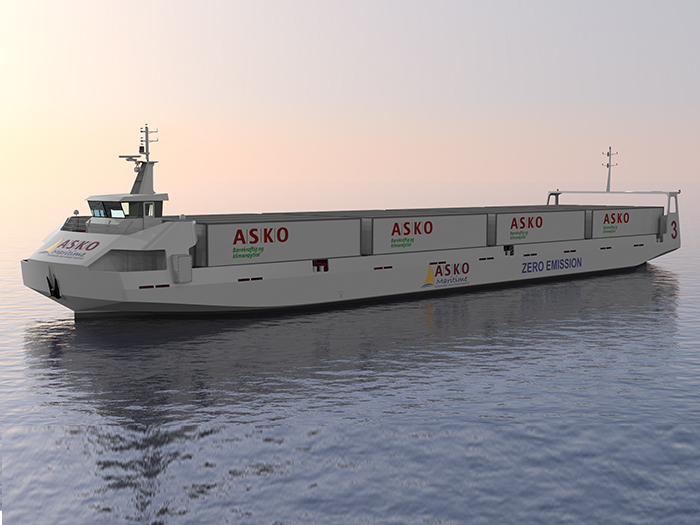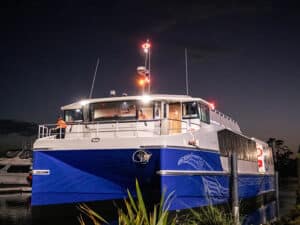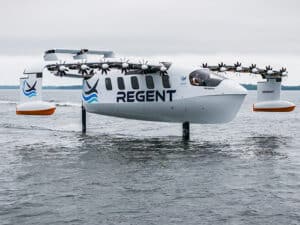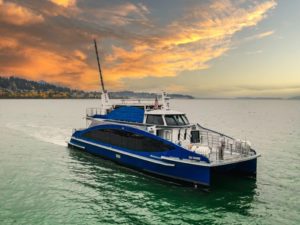
Autonomous freight ferries will feature Kongsberg and Massterly solutions
Written by Nick Blenkey
Ferries will operate across Oslo Fjord [Image: Cochin Shipyard]
Norwegian grocery distributor ASKO has awarded Kongsberg Maritime and Massterly (a Kongsberg Wilhelmsen joint venture) contracts to supply solutions for the two autonomous, all electric freight ferries it has on order at India’s Cochin Shipyard (see earlier story).
Kongsberg Maritime and Massterly will supply the vessels with autonomous technology and will manage their operations at sea.
The fully electric ships will replace 2 million kilometers of truck transport, saving 5,000 tonnes of CO2 every year.
ASKO currently transports its cargo by using more than 800 trucks a day and, at present, road transport is the single mode of transportation to link its warehouses on the western side of the Oslo fjord with its distribution center on the eastern side.
The new RO/RO vessels will provide a zero emission transport alternative.
“We have a clear ambition to be climate neutral and have set ambitious goals, including being a self-sufficient provider of clean energy and having 100% emission-free transport by 2026. These innovative ships are key to fulfilling that ambition and will form an essential component of a zero-emissions logistics chain linking our facilities,” says Kai Just Olsen, Director, ASKO Maritime. “Fully electric trucks will take the cargo between the warehouses and the ports of Moss and Horten and, in shipments of 16 the trailers will be transported across the fjord on the battery-driven vessels. This solution is cost effective, sustainable and will remove trucks from a heavily trafficked road.”
Norwegian government agency ENOVA is providing NOK 119 million (about $14 million) in support for the project, including the required port infrastructure, in line with its commitments to reduce emissions and transfer transport from road to sea where feasible.
The vessels will be equipped with the technology required for zero emission and unmanned operation by Kongsberg Maritime, while Massterly will ensure ship management and safe operations from a shore-based Remote Operations Center.
The two vessels will initially operate with a reduced crew, before moving towards unmanned voyages.
Egil Haugsdal, President, Kongsberg Maritime, said: “When we teamed up with Wilhelmsen to form Massterly, this was exactly the kind of project we wanted to enable. By working together with us to bring autonomous, electric solutions into everyday use, ASKO is helping to achieve a sustainable, safer future for maritime operations while also demonstrating the efficiencies these technologies can deliver.”
Thomas Wilhelmsen, CEO of Wilhelmsen Group, added: “The ASKO contract illustrates how Massterly is key in making autonomy a reality for short-sea shipping. We are proud to be the world’s first ship management company to operate unmanned vessels for commercial use. Now we are one step closer to our goal of enabling sustainable trade: through cost effective, safe, and environmentally friendly logistics.”
Since the ASKO operation is within Norway’s coastal jurisdiction, the Norwegian Maritime Authorities (NMA) must be satisfied that a sufficient level of safety has been achieved before it will issue an approval of operation for these vessels. NMA will therefore follow the project through a detailed risk assessment, based on IMO 1455 guidelines on to equivalent and alternative designs, new technology, verification, and approval for operation. DNV GL will also support this process as an independent third party.
The vessels, which are due to be delivered early in 2022, have been designed by Norwegian vessel designer Naval Dynamics and will be constructed at the state-owned Cochin Shipyard in India.
The functionality enabling autonomous operation will be implemented and tested after arrival in the operation.
Vessel details:
- Overall length: 66 meters
- Breadth molded: 15 meters
- Design deadweight: 448 tonnes
- Design draft: 1.70 meters
- Scantling deadweight: 573 tonnes
- Scantling draft: 1.90 meters
- Battery capacity: 1,800 kWh
Each vessel will be able to load, carry and discharge 16 EU-spec trailers. The vessels are being constructed in accordance with DNV GL rules with the Class notation: 1A1 + Battery Power + RP (1,40) + R3 + General Cargo + BIS.
The battery capacity enables fully loaded sailing for four hours at eight knots.




